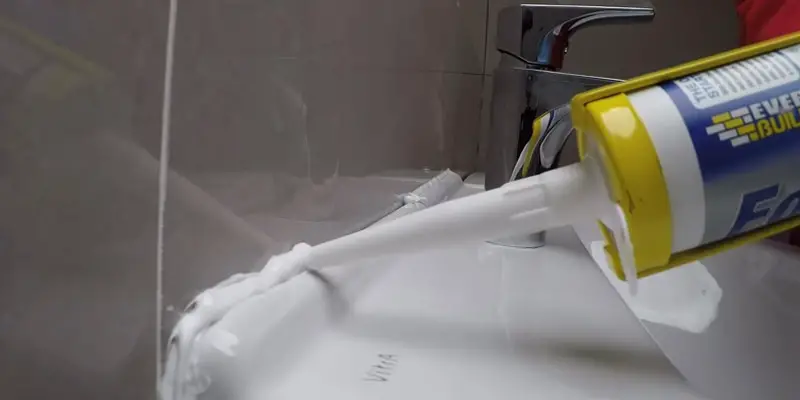A shower base is a common element in a bathroom. Using caulk to keep a shower base from mold attack is essential.
Moreover, it stops water from getting into seams, handles, joints, corners, and edges, preventing mildew, mold, and water damage.
So, stop being confused about whether should you caulk around a shower base or not. Because it is clear that caulking is essential for a shower base. But which caulk?
In this article, we will discuss it elaborately.
Should You Caulk Around Shower Base: Importance Of It
It’s common for bathrooms to have ventilation issues. In case you are interested in knowing how to caulk a shower like a pro. Then it is essential to know about caulking and sealing around a wet area because it is tricky.
As a result, you cannot ignore the importance of using good caulk for the shower base. It is sometimes also applied to shower pans.
So, if you’re debating whether to caulk tile floor to the shower pan, go ahead and do it.
Suppose someone is not sure about finishing a DIY repair of a shower base. He should hire an expert in the case. Caulking around a shower or tub and the surrounding walls is essential to preventing water damage.
When caulking is done correctly, a caulked shower should be watertight, mildew and mold-free, and resistant to water damage.
Before applying the caulk, be sure of two things:
- Get to know the different types of caulk.
- Apply the right amount to the shower to keep leakage out.
The Common Type Of Caulk For Shower Base
Without caulk, water can slowly get into places around the shower base. And it can be the cause of structural damage. In such cases, caulking is a waterproof solution enhanced with temperature variations and doesn’t break like concrete.
Caulks that are commonly used include the following:
Type 1- Acrylic Latex Caulk
When it comes to water, acrylic latex doesn’t work as same as silicone. However, this caulk can be an alternative option when someone is looking for a caulk for their shower.
But you can still use it in the shower, although acrylic latex isn’t as durable as 100% silicone.
Type 2- 100% Silicone
Furthermore, silicone caulking is more waterproof than acrylic latex. Because of this, it is a better choice for showers, faucets, and other moist areas.
Silicone caulk is also more durable against both heat and cold, and it comes in a variety of colors. Moreover, silicone is the best caulk for bathroom sinks.
Recommended: How To Replace Silicone Around Sink?
Type 3- Acrylic Silicone Sealant
Acrylic sealant is mainly used on various surfaces, including glass, metal, and ceramic, making it ideal for use in kitchens, bathrooms, and showers.
Moreover, the best bathroom caulk to prevent mold is acrylic silicone sealant.
Type 4- Acrylic Tile Sealant
This caulk can protect the shower base but is not better than silicone. But acrylic tile sealant is best for doors and window frames. So, concentrate on how to caulk a shower door with this tile sealant.
Type 5- Adhesive Caulk
It is possible to utilize caulk as glue in specific situations.
They are quite flexible, making them excellent for holding things that need to move or bend only a little. It is ideal for use in showers, around windows, and other areas where joints and seams need to be sealed.
Consider whether you are planning to paint your shower before you start caulking. Then this glue can help. But paint cannot be applied over some caulks, such as pure silicone.
Therefore, picking up latex caulk or siliconized latex sealant for the shower will be best. However, to keep moisture out and get a polished look, use only as much caulk as necessary.
On the other hand, caulk in a neutral white color is the ideal choice. A clean layer of caulk can be ensured with the help of painter’s tape and a damp finger. Let your caulk cure for at least 24 hours to ensure a beautiful shower.
The Additional Necessity Of Using Caulk In Bathroom Base
When you require a high-quality caulk to seal your shower or are looking for the best caulk for bathtub use silicone. Choose silicone.
Otherwise, it can be a cause of cracking or peeling. But, again, these are the result of the lack of proper caulking.
However, caulk is required to help avoid the formation of high humidity. The presence of a barrier in a shower, such as cement and ties, may not be enough to prevent water.
In the same way, it is used to absorb water through seams, handles, joints, corners, and edges. As a result, it is used to minimize the growth of mildew, mold, and other water-related problems.
To solve this problem, make sure to ventilate your bathroom. Work carefully, and use as much caulk as is necessary to create a smooth, waterproof barrier in your bathroom.
Allow sufficient time for the caulk to dry completely before resuming the use of the shower.
Steps Of Using Caulk
Prepare the shower base before you start caulking. Remove old caulk, grime, dirt, and debris before proceeding. Ensure that you have appropriately dried yourself after taking a shower before starting your caulking.
It is beneficial to lay down strips of painter’s tape before applying caulk to ensure a clean application. Then, spread the caulk in a line along the shower base, be careful not to overexpose the area.
Before the caulk dries, smooth it evenly and wipe away any extra with a moist finger or tool to prevent it from drying out.
Strip the painter’s tape and allow the sealant to cure for a total 24 hours before removing the tape.
According to the manufacturer, the best caulk to use for a shower base is a siliconized latex or siliconized acrylic product.
Caulking A Shower Enclosure
It is common for water to escape in showers with glass doors, creative designs, or even a long shower curtain with an inserted magnet at the bottom.
A shower enclosure must be caulked to prevent mildew and mold growth and prevent excessive moisture damage from occurring. If the enclosure has connections to the shower, try to limit the water that can leak through the seams.
To create lines around a shower enclosure at connecting points, use a siliconized sealant or caulk with silicone additives.
As a result, the shower will appear more stylish. However, water will still be able to drain from the bottom of a shower door track if the caulk is only applied to the outside of the way.
Do Clean leftover caulk from the surface where the caulk was applied. Follow the manufacturer’s instructions and thoroughly clean the area before allowing the caulk to set.
Caulk should be applied to existing lines only if the old caulk is clean. The new caulk should completely cover the old caulk and the previous work.
How Long To Let Shower Dry Before Caulking?
Allow the shower at least 24 hours to dry before caulking. Whenever you need to speed up the procedure, open the windows, turn on a fan in the bathroom, and dry off the bathtub with a towel.
It usually takes at least 24 hours after caulking your shower for it to dry and set before you can use it. Allow the sealant or caulk to dry completely before exposing it to humidity.
It is possible to wait a minimum of 12 hours after taking down a caulk in some instances, although it is not suggested. Allow plenty of time for the floor of the shower, base, and enclosure to dry after caulking.
Before dealing with caulk, be careful to eliminate any old caulk, filth, trash, or broken parts. Older caulk lines that are clean and dry can be caulked over.
FAQ
Is it better to caulk or grout the shower base?
How to caulk a shower door?
Between the shower pan and the tile, do you apply caulk?
Wrapping Up!
Stop worrying about whether you should caulk around the shower base or not. Because caulking around a shower pan and base both requires caulking. So, apply caulk on the shower base to get a long-lasting clean outcome.
Want to Learn More:
- How to Get Rid of Mold in Shower Caulk – Multiple Solution
- Should You Caulk Cabinets Before Painting?
- 3 Causes Why Does Clear Caulk Turn White?
- How To Caulk Door Trim And Jambs – Particular Steps Explained
Hello! this is John Cox. If I’m not wrong, you love Home. Right? And you already met one of them who’ve been in this field since 2005 and still go on. According to my interest, I’ve started this blog to share my thoughts about Home sectors, and you’ll love it.


